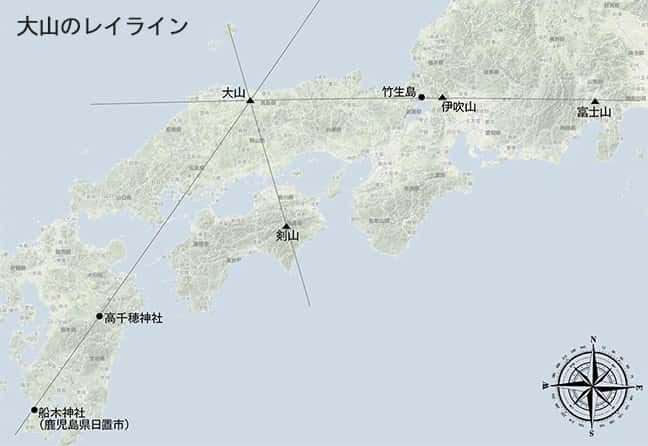Reihou Daisen
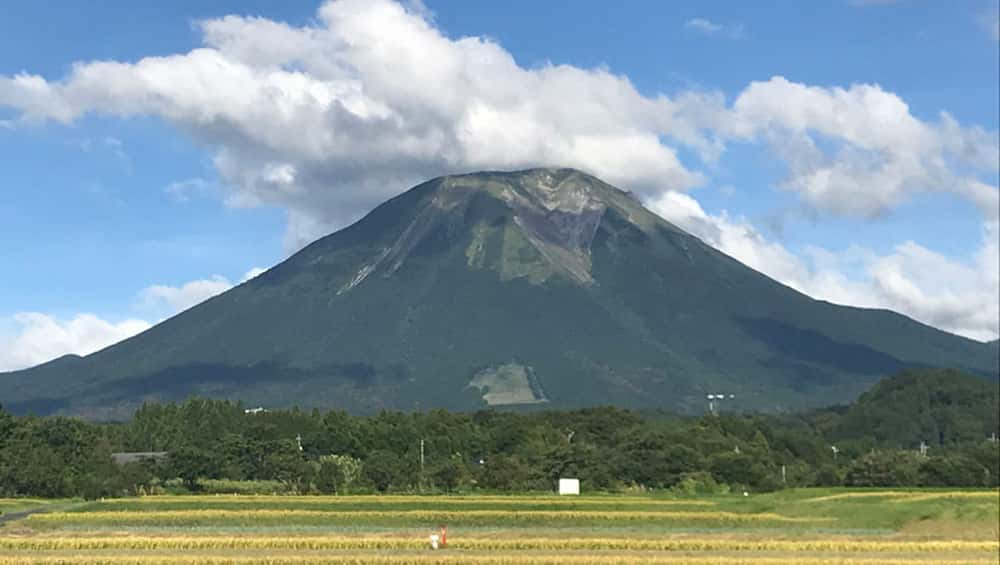
Spectacular View of Daisen in Summer
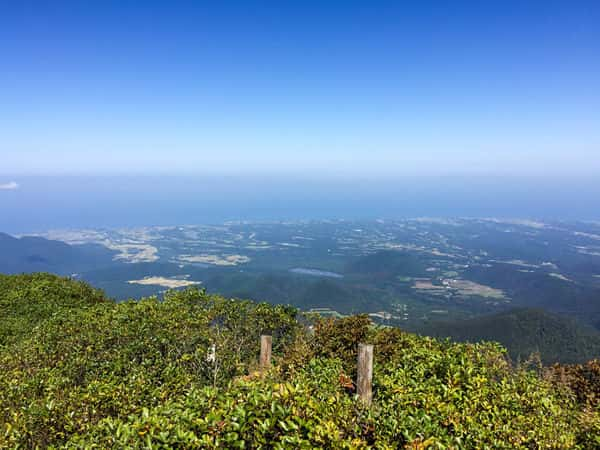 Panoramic View of the Sea of Japan from the Summit
Panoramic View of the Sea of Japan from the Summit 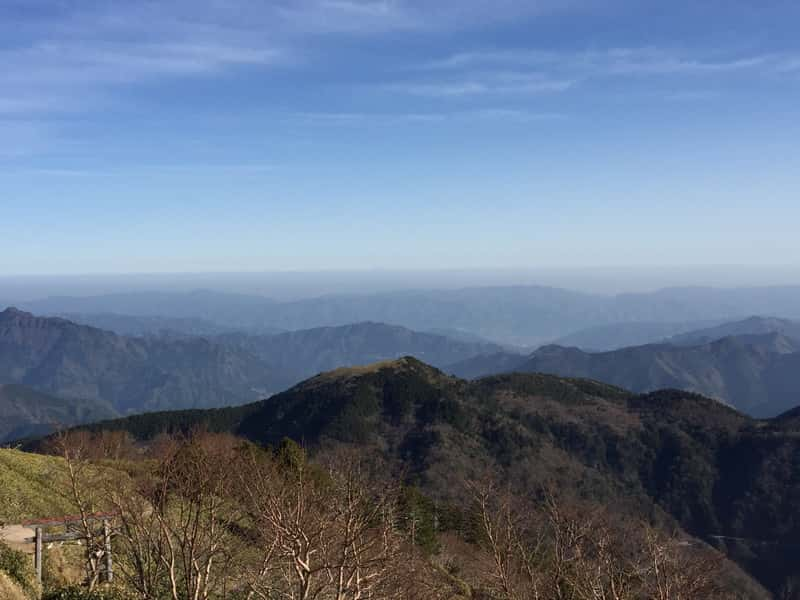 View of Daisen bordering the Sea of Japan from the summit of Tsurugisan
View of Daisen bordering the Sea of Japan from the summit of Tsurugisan Daisen is the highest peak in Tottori Prefecture standing at 1729 meters above sea level. Daisen is clearly visible from the summits of Ishizuchisan and Tsurugisan. Daisen is also called “Ookaminotake,” or the “god peak”, and the name is mentioned in Izumo no Kuni Fudoki that was written in the Nara period (710-794). This reihou has always been revered as a sacred mountain and is a symbol of the entire region as “the mountain where the Great God resides”.
Daisen is read as “big mountain.”. The on-yomi of the mountain are “san” and “sen,” the latter of which is said to be derived from the Chinese go-on reading. The go-on reading was used earlier than the kan-on readings, which have been prevalent since the 7th-8th century, and many of these words are also used in Buddhist terminology. Therefore, the reason Daisen came to be called “Daisen” seems to include an element of ancient people putting their love and faith into this mountain.
Daisen, A Mountain of Shugendo
Daisen is said to have been founded in the Nara period by Yorimichi who contributed to the creation of the Izumo country. According to the Daisen-ji Engi (History of Daisen-ji) Daisen, together with Kumano and Kinpusan, was originally one mountain, but was divided into three mountains and became the object of mountain worship. Daisen-ji was also built in the Nara period and was located at the foot of Daisen. The temple then became the place of training for Shugendo practitioners. After the Heian period (794-1185), the temple had grown to be a powerhouse and grew to have more than 100 temples and 3,000 priests at its peak. Then, in the Muromachi period (1336-1573), Daisen became known as a center of Tendai Sangaku Buddhism, and consequently Daisen was recognized and established as a mountain of Shugendo.
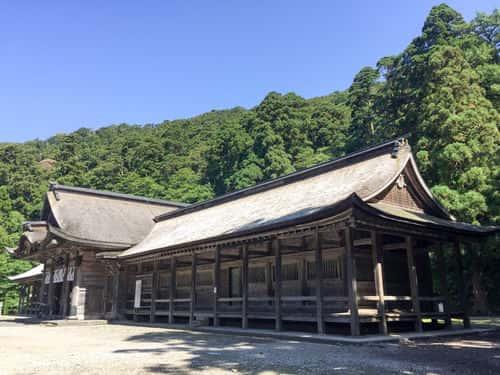
Okumiya Shrine of Oogamiyama ShrineFrom the precincts of Daisen-ji, a stone-paved path with natural stones leads 700 meters uphill to the Okumiya Shrine of the Ogamiyama Shrine, which is famous for its magnificent Gongen-zukuri, one of the largest in the country. Traditionally, the site began as a place of far-off worship for ascetic ascenders to Daisen, and it has a long history as the main shrine of Daisen-j, the main temple of mountain worship for the entire Daisen area. The shrine was then changed into the Okumiya Shrine of the Ogamiyama Shrine, where the deity Okumiki-no-kami, who contributed to the creation of the country in the era of the gods, was enshrined. The octagonal portable shrine protected in the inner shrine was built in the late Edo period (1603-1868), and its pedestal is over 3 meters high and weighs as much as 1 ton.
Daisen and Funaki, Takachiho
The ley lines of Daisen are organized into a very simple lineation. Just as important as Mt. Ibuki is the fact that Daisen is connected to Mt. Fuji at approximately the same latitude. Mt. Ibuki is also on that same ley line, as well as the small sacred island of Chikubujima on Lake Biwa. Daisen shared the power of the earth with both Mt. Ibuki and Mt. Fuji. Also, just as many other ancient sacred mountains are tied to Takachiho, Daisen is tied to Takachiho by a ley line.
Ancient migratory people crossed the sea northward from the Nansei Islands and sailed from Kyushu to Shikoku and Awaji. On their way, they used the Funaki Shrine in Hioki City, known today as Kagoshima Prefecture, as a base for anchoring their ships at the southernmost tip of Kyushu. In the 1st and 2nd centuries, the Funaki clan is assumed to have been a maritime tribe that led the royal family to the Japanese archipelago. Not only did they lead the ships to Ise during the Motoise pilgrimage, but they also established bases on the Kii Peninsula, Harima, Awaji, and Wakasugiyama in Shikoku. Takachiho is located on the ley line connecting the Funaki clan‘s ancient base and Daisen. This suggests that a place as deep in the mountains as Takachiho may have been a sacred place that shares the same ley line as Daisen.
Daisen, which can be seen not only from the waters of the Sea of Japan but also from Tsurugisan and Ishizuchisan in Shikoku and is also connected to Funaki, is one of the oldest ports in Japan. The famous sacred site Takachiho makes it a mountain worthy of being named as one of the Eight Reizan of Japan.

